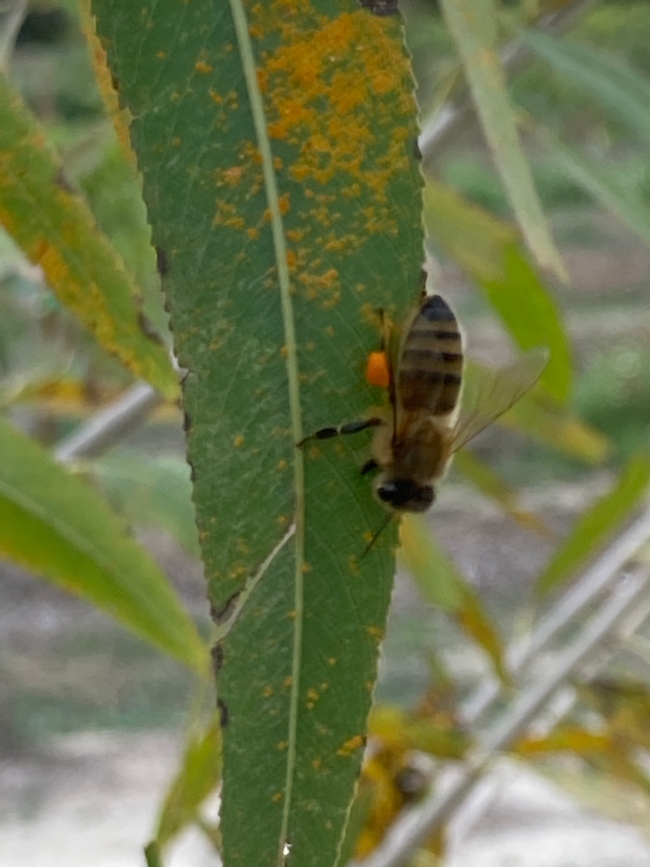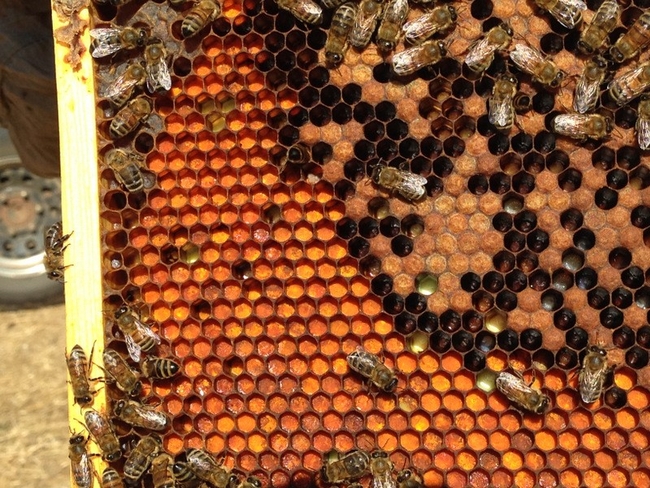
Posts Tagged: honeybees
Fungus-eating Honeybees??????
Image: Allen King
A Fillmore grower recently reported honeybees collecting rust spores on willow trees!!! Her baskets are loaded with rust spores. Rust-collecting honeybees are reported by others so it's not an unusual occurrence.
From: Randy Oliver, “Fried Eggs” Identified! https://scientificbeekeeping.com/fried-eggs-identified/ Oliver shows bee-collected rust pollen from poplar trees in Spain in hive frames.
Quote: "Above is a photo of a typical comb filled with beebread consisting of rust fungus spores. Note the lousy brood pattern and the dying brood. When the colony is feeding upon this beebread, it goes downhill quickly. However, if we feed the hive several pounds of high-quality pollen sub, it will turn around immediately and grow again.
Antonio Pajuelo (pers comm) also reports a correlation between the consumption of poplar rust spores and colony mortality, but doesn't know whether it is due to spore toxicity or lack of better nutrition. It may be that the collection of rust spores is due to the lack of more attractive and nutritious floral pollen, and as such would simply be a generic indicator of poor colony nutritional status.
On the other hand, Schmidt (1987) found that caged bees fed Uromyces spores as a sole protein source actually had their lifespan reduced compared to those fed sugar syrup only—strongly suggesting that the spores were toxic. The spore-fed bees lived about 20 days less than those fed the most nutritious pollens!"
John Menge, a retired UC Riverside plant pathologist and mycologist has this reasoning:
The bee rust problem is very interesting.
I would have liked to work on that problem when I was at Riverside.
Two thoughts:
First I thought poplar rust was a Melampsora not Uromyces.
All the old literature gave the Uromyces name to all Uredospore stages.
Second, as you know, rusts have five different spore stages.
It would help to know what spore stages are in the hives.
One spore stage is pycniospores.
It is the spermatia stage and is sweet as honey.
It attracts all types of insects including bees.
Its job is to promote fertilization of the fungus so the bees are pollinating the fungus.
In the process of gathering the spermatia sugar, the bees are inadvertently gathering urediniospores.
Or perhaps there is lingering pycnia sugar on the urediniospores.
Or perhaps there are other attractants on the spore so the bees will disperse them.
At any rate I can tell the researchers are entomologists because they are worried about the bee colonies.
Mycologists worry about the cottonwood trees and the success of the rust fungi.
Apparently the fungi have outsmarted the insects again.
Seeking Native Bees
Over the last 100 million years, native species shaped our ecosystems. Now, farmers bring in non-native honeybee hives by the truckload to pollinate hectares of non-native crops. And the honeybees could be affecting how native bees do their job. In a 2013 study, Lucas A. Garibaldi found that “overall, wild insects pollinated crops more effectively; an increase in wild insect visitation enhanced fruit set by twice as much as an equivalent increase in honeybee visitation.” But native bees face serious competition: Victoria Wojcik, research director for Pollinator Partnership, notes that honeybees could drive out native bees when the two compete for flowers.
The USGS Native Bee Inventory and Monitoring Program designs and develops large and small scale surveys for native bees. As part of that program they also develop identification tools and keys for native bee species. One aspect of creating those tools is creating accurate and detailed pictures of native bees and the plants and insects they interact with. This site is designed to provide easy access to our photographs so that they may be freely used. There is no need to ask permission for any use of these photographs. You can download the original version directly from Flickr at your convenience: https://www.flickr.com/people/usgsbiml/
Volunteers have sent in photos and samples from all over the world. The survey currently has over 4,000 images, offering an up-close-and-personal encounter with our smallest flora and fauna. At this greatly enlarged scale, the bees look otherworldly. Their compound eyes are traced in striking patterns, and orbs of pollen delicately latch on to their surprisingly furry backsides. This small selection of bees from the American West demonstrates an immense, previously unseen diversity and shows viewers there's a lot more to the story of bees than just honeybee hives.
Learn how to collect bees for the survey: http://bio2.elmira.edu/fieldbio/handybeemanual.html
Please contact Sam Droege for further information at sdroege@usgs.gov or or 301-497-5840 or visit their website at: www.pwrc.usgs.gov/nativebees/
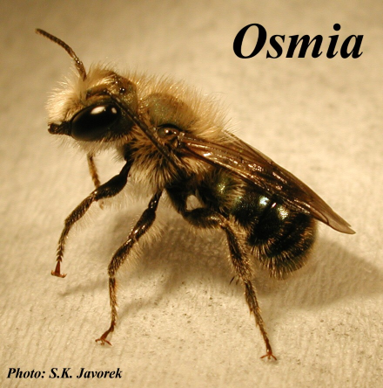
Osmia
Increasing Avocado Pollinators?
Avocado is a neotropic tree which has been commercialized world-wide, yet it's native pollinators have been little studied. The most frequently studied pollinator has been the old-world insect, Apis mellifera. In commercial orchards it is common practice to introduce honey bee colonies, although it is not clear exactly what the extent of their effect is in California orchards in the presents of native bees and other pollinators. The purpose of this study is to evaluate the range of avocado flower visitors and to assess whether those numbers can be affected by the introduction of gardens that might promote their numbers in the orchards during the avocado bloom period.
Measuring pollinator performance is difficult because of weather impacts, alternate bearing habit and the high level of fruit shedding in avocado. In this study, pollination gardens have been established in three avocado orchards in coastal California near Santa Barbara, just north of Los Angeles. These gardens have been established since 2014 with a variety of perennials that can supply nectar and pollen over the year and especially during the prolonged flower season. The three orchards where the gardens are established each exceed 40 ha. Gardens have been established in just one portion of the orchards, so that flower visitation can be assessed near and far from the gardens. The individual visitation activity of flower visitors was evaluated per unit time and their abundance on avocado flowers near the gardens and away from the gardens. Visitation was also similarly assessed on the pollinator gardens. Pan traps were also used to assess the presence of native bees in the orchards.
The most abundant visitors in all years have been Syrphid spp. along with a variety of other flies and wasps. The most abundant native bee species have included Ceratina, Halictus, Agapostemon and several andrenid species. The highest diversity and abundance of visitors has occurred after the high rainfall year of 2016/17 after previous drought years.
Read more at:
http://ceventura.ucanr.edu/newsletters/Topics_in_Subtropics76791.pdf

honeybee at hive
Moths, Flies, Beetles Pollinating Avocados? O, MY!
And doing it in the dark?
In a recent paper, David Pattemore and associates reveal some fairly different observations about avocado flowering. One, that the female stage can be open and potentially receptive to pollination at night. And Two, that moths and crane flies amongst other nocturnal insects are visiting the flowers and carrying pollen!!! These are two very new observations, made possible by the digital world we live in.
Of course, insect visitation doesn't mean fruit set. Is there pollination, transfer of pollen to the female stage? Is there enough pollen? Is it the right pollen? Is it the right temperature for fertilization to occur? Whatever else needs to happen for fruit set, is it happening?
But these observations are opening up new discussion topics for the avocado world.
LOW OVERNIGHT TEMPERATURES ASSOCIATED WITH A DELAY IN ‘HASS' AVOCADO (PERSEA AMERICANA) FEMALE FLOWER OPENING, LEADING TO NOCTURNAL FLOWERING
David Pattemore1,2*, Max N. Buxton1, Brian T. Cutting1, Heather McBrydie1, Mark Goodwin1, Arnon Dag3
1The New Zealand Institute for Plant & Food Research Limited, Ruakura Research Centre, Hamilton 3210, New Zealand
2School of Biological Sciences, University of Auckland, Auckland, New Zealand
3Gilat Research Center, Agricultural Research Organization, 85280, Israel
Abstract—Avocado (Persea americana) has synchronously protogynous flowers: flowers open first in female phase before closing and opening the next day in male phase. Cultivars are grouped based on whether the flowers typically first open in female phase in the morning (type A), or in the afternoon (type B). However, it is known that environmental factors can alter the timing of flower opening, with cold temperatures being shown to affect the timing of flowering. The aim of this study was to investigate how low spring temperatures in New Zealand affect the flowering cycle of commercial avocado cultivars, focusing primarily on the receptive female phase of ‘Hass', a type A cultivar. Time-lapse photography was used to assess flower opening times of ‘Hass' over three years. Decreasing minimum overnight temperatures were associated with a delay in the timing of ‘Hass' female flower phases and resulted in nocturnal flowering of both male and female phase flowers. We recorded insects visiting female flowers at night, and some nocturnal flower visitors collected were carrying avocado pollen. Our study suggests that nocturnal pollination needs to be considered for avocados grown in temperate regions. Furthermore, as the timing of the female phase of ‘Hass' varied significantly with overnight temperature, the activity patterns of potential pollinators need to be considered to ensure adequate pollinator activity across the range of times in which ‘Hass' flowers are receptive.
Eight different invertebrate orders were captured from avocado flowers at night. Coleoptera, Diptera and Lepidoptera were the most frequently caught floral visitors, but it was coleopteran, dipteran and neuropteran individuals that carried the greatest number of pollen grains on average. This is an important distinction to make, as not all floral visitors behave as pollinators: visitation does not necessarily infer pollination. Species such as Costelytra zealandica (Coleoptera), Micromus tasmaniae (Neuroptera), along with Tipulidae and Sylvicola species (Diptera) may be especially important, as these were both frequently caught and often carried a high number of pollen grains. Compared with diurnal pollination, nocturnal pollination is poorly understood and relatively little research in New Zealand has tested assumptions that nocturnal floral visitors can act as pollinators.
This is an interesting read and introduces further areas of pursuit to understanding what brings on fruiting in the wild avocado.
Read On:
click on Download this PDF file
Rhapsa scotosialis – a potential avocado pollinator?
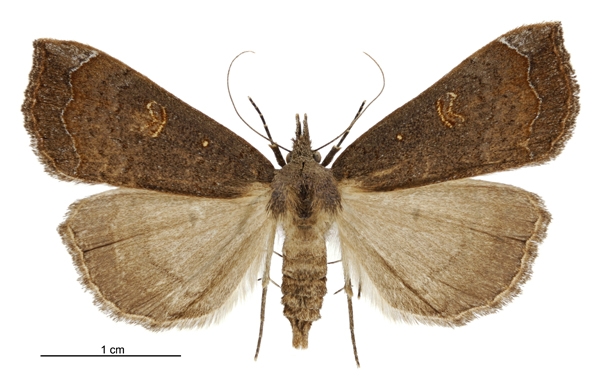
Rhapsa scotosialis female
Protecting Wild Native Bees from Unintended Pesticides
Where sufficient habitat is available, wild native bee species often provide all of the pollination services needed for high crop yields and fruit quality. Depending on the species, native bees may nest in underground tunnels, hollow plant stems, and tunnels in wood. Bumble bee colonies favor small cavities under lodged grass, in abandoned rodent burrows, in trees, or old bird nests. These unmanaged pollinators are an on-site natural resource, and unlike honey bees, cannot be moved from the field when pesticides are used. In fact, many ground-nesting species, such as squash bees, long-horned bees, mining bees, and sweat bees, construct their nests in the midst of annual and perennial crop fields. To protect these bees, ensure that drifting pesticides never contact adjacent habitat, even when crops or wildflowers are not in bloom. Scout crop fields, and protect ground nests of solitary bees and bumble bees from insecticide spray. Learn more about managing pesticides and protecting bees at:
UC-IPM: http://www2.ipm.ucanr.edu/beeprecaution/
Oregon State University Extension: https://catalog.extension.oregonstate.edu/sites/catalog/files/project/pdf/pnw591.pdf
Xerces Society: www.xerces.org/
Bee Book: http://www.helpabee.org/
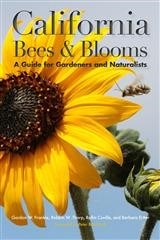
bees and blooms frankie

